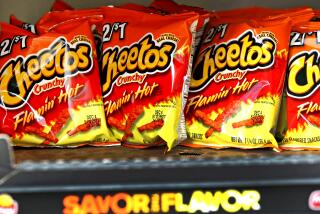Food technology has been bad for human health since long before the invention of high-fructose corn syrup
- Share via
The diet of modern Americans bears little resemblance to the foods our ancestors ate, and this discrepancy is often noted in discussions about the causes of the current “obesity epidemic.” The argument goes like this: Since fat and sugar were historically hard to come by, our bodies are built to hold on to them to help us get through the lean times. This may have served us well in the caveman days, but not so much in the era of the KFC Double Down sandwich.
Dr. David Ludwig, director of the Optimal Weight for Life program at Children’s Hospital Boston, takes a fascinating look at how innovations in food technology have backfired for humankind over the millenia in this week’s edition of the Journal of the American Medical Assn. The roots of America’s weight problem go back much further than the invention of high-fructose corn syrup and the introduction of frozen TV dinners.
Indeed, Ludwig begins his story with early hominids, who got by on a diet consisting primarily of plants and insects. Then, about 2 million years ago, the first “transformative technology” arrived on the scene: stone tools. These made it possible to hunt large animals and – along with the discovery that meat could be made safe to eat by cooking it in a fire – allowed humans to evolve large brains.
Since then, however, technological advances in food production have done at least as much harm as good, Ludwig argues.
RELATED: If food addiction exists, blame the brain -- not the cookies
Though the development of grain-based agriculture roughly 12,000 years ago made it possible for the human population to multiply and for advanced civilizations to develop, it also made for a less nutritious diet, since grains contain fewer nutrients per calorie. As people shifted from hunting and gathering to an agrarian lifestyle, their average height dropped by several inches, Ludwig explains. Diseases caused by a lack of protein and nutrients also became widespread for the first time.
From there, Ludwig jumps to the Industrial Revolution, which (among other advances) made it possible to mass produce flour and sugar. “This era culminated in the widespread dissemination of ultra-processed products such as fast food throughout the United States,” he writes.
As a result, humans today get much – if not most – of their calories from just three kinds of plants: corn, wheat and soy. This is why, when CNN Chief Medical Correspondent Sanjay Gupta had a strand of his hair tested in a UC Berkeley laboratory in 2007, 69% of the carbon in it was traced to corn.
Processed foods tend to emphasize tasty ingredients like sugar, salt and fat. To decrease transportation costs and extend shelf life, they contain less water, leaving each morsel of food more densely packed with calories. The detrimental health effects of these innovations are obvious.
But we can’t simply abandon food technology, Ludwig writes – indeed, if the nearly 7 billion people on the planet are to be fed, we must embrace it. However, we should keep in mind that “reducing the burden of obesity-related chronic disease requires a more appropriate use of technology that is guided by public health rather than short-term economic considerations,” he concludes.
That’s hard to argue with. But somehow, we’re not quite ready to start holding our breath.
You can read the commentary for yourself here.
RELATED: Choose foods, not nutrients







